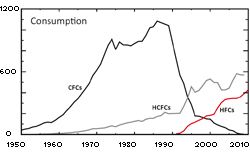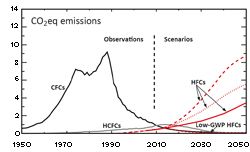THE United Nations has urged that HFCs, which are increasing in the atmosphere at a rate of 8% per year, could cancel the climate benefits won by the phase-out of CFCs and other ozone-depleting substances.
HFCs which have been widely used to replace CFCs and HCFCs are assessed by the UN's recent report
HFCs: A Critical Link in Protecting Climate and the Ozone Layer, produced by the UN Environment Programme (Unep). The report suggests that the global warming potential of HFCs in 2050 could be comparable with current emissions from the global transport sector.
Although their current contribution to 'climate forcing' is less than 1% of all other greenhouse gases combined, HFCs have the potential to substantially influence climate in the future, says the report
HFCs are rapidly increasing in the atmosphere as a result of their use as ODS replacements. For example, CO
2 equivalent emissions of HFCs (excluding HFC-23) increased by approximately 8% per year from 2004 to 2008.
The report says that: 'As a consequence, the abundances of HFCs in the atmosphere are also rapidly increasing (Figure ES 3). For example, HFC-134a, the most abundant HFC, has increased by about 10% per year from 2006 to 2010. In the future, HFC emissions have the potential to become very large. Under current practices, the consumption of HFCs is projected to exceed by 2050 the peak consumption level of CFCs in the 1980s.'

Figure ES 1: Global consumption (in kilotonnes per year) of ozone depleting CFCs and HCFCs. The
phasing in of HFCs as replacements for CFCs is evident from the decrease in CFC usage concomitant
with the increasing usage of HFCs. Use of HCFCs also increased with the decreasing use of CFCs.
HCFCs are being replaced in part by HFCs as the 2007 Adjustment to the Montreal Protocol on HCFCs
continues to be implemented. Thus, HFCs are increasing primarily because they are replacing CFCs
and HCFCs.

Figure ES 2: Trends in CO2eq emissions of CFCs, HCFCs, and HFCs since 1950 and projected to 2050.
The HFC emissions scenarios are from Velders et al. (2009) and Gschrey et al. (2011). The low-GWP
HFC line represents the equivalent HFC emissions for a scenario where the current mix of emissions
(with an average lifetime of HFCs of 15 years and an average GWP of 1600) was replaced by a mix of
low GWP HFCs (with an average lifetime of less than 2 months or GWPs less than 20).
